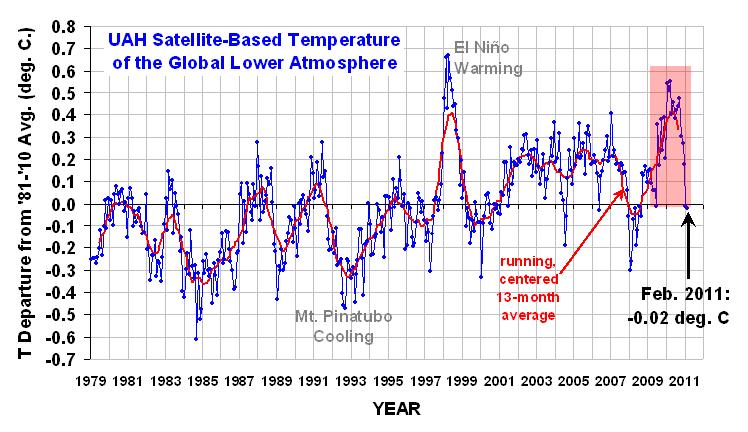Even for a near record-breaking year like 2010 the broader context is more important than a single year. “Certainly, it is interesting that 2010 was so warm despite the presence of a La Niña and a remarkably inactive sun, two factors that have a cooling influence on the planet, but far more important than any particular year’s ranking are the decadal trends,” Hansen said.
Hansen is an honorable man, so how could we question his claim that the 2010 El Nino spike was actually a La Nina trough – but what will he say about 2011?



Shocking that he would say there was a La Niña in 2010. Every one knows it started this january 1st! and how could he miss all that solar activity!
Everyone knowledgeable about climate knows that there is a four to six month lag of surface temperatures behind ENSO. That apparently includes neither you nor Hansen.
Steve, it certainly doesn’t include me. I would have to ask Hansen about that, unless that is you have an unverified article that interviews him on the subject!
You think?
11 months of El Nino + 1 month of La Nina = 1 La Nina year?
If Hansen is really that dim, it is not surprising his forecasts are so far out.
paul,
Steve used the phrase “el niño year”, not Hansen.
Steve knows how to “spin”! Any one who read “it is interesting that 2010 was so warm despite the presence of a La Niña and a remarkably inactive sun” would infer that Hansen was insinuating that 2010 was warm despite the presence of a La Nina.
Sorry, I should have said Tony knows how to spin, not Steve.
Moh…..we knew that. Try to keep up. The problem arises when
youwe realize 2010 temps were dominated by El Nino temps……it was only toward the end of 2010 that surface temps started reflecting La Nina.lol, in that case, ……sorry, disregard.
Hi Tony
“Steve used the phrase “el niño year”, not Hansen”
My point is that Hansen implied 2010 was a La Nina year just because La Nina started in the last couple of months
The useless Slingo woman in our Met Office over here has produced the same lies.
Hansen certainly is implying that la Niña influenced global temps in 2010. If Steve is correct and.
So if a “remarkably inactive Sun”, by Hansen’s own admission, has a cooling influence on the planet, does it also not follow that a remarkably active Sun – and the Sun was more active between 1950 and 2000 than at any time in the 400-year Sunspot record – would have a warming effect on the planet?
http://upload.wikimedia.org/wikipedia/commons/2/28/Sunspot_Numbers.png
Anything is possible,
I think it kind of depends on what you mean by remarkably active sun. I know of no climate scientist that attributes the increase in temps up to now because of increase in solar output
You don’t get out much.
TD – The opposite to what Hansen means by a “remarkably inactive Sun”. If he;ls going to use hyperbole to boost his case, I have no qualms about using it against him.
Here’s one to get you started :
http://nzclimatescience.net/index.php?option=com_content&task=view&id=713&Itemid=1
Steve,
Galactic cosmic rays do not come from the Sun.
TonyD:
You also do not read much!
Tony Duncan
“Shocking that he would say there was a La Niña in 2010.”
Defending the indefensible? Let me guess, you are a CAGW alarmist.
The east coast blizzards during early 2010 were supposedly a result of El Nino and as Steve says, there is a several month lag once La Nina sets in. So even with the false assumption that 2010 was near record warm, La Nina may not have played that big a part.
Andy,
Once again you write something reasonable
http://www.bom.gov.au/climate/enso/monitoring/nino3_4.png
Here is the daily UAH lower troposphere temperatures in 2010 and 2011 showing the global, southern hemisphere, northern hemisphere, tropics and global numbers.
The 3 month (and occasional 8 month lag) translates into 2010 being an El Nino year and 2011 being a La Nina year.
Only a small drop of -0.9C from El Nino peak to La Nina current.
http://img860.imageshack.us/img860/6513/dailyuahtempsmar82010.png
Lets not forget the SOI especially if it turns out the solar forcing is top down. It looks like McLeans seven month lag between global temps and SOI is holding up.
http://ioc3.unesco.org/oopc/state_of_the_ocean/atm/soi.php
If the current decline represents where the SOI was in June then based on the current record value we are head for -2 degrees from the last years el nino high.
http://processtrends.com/images/RClimate_UAH_Ch5_latest.png